Great Dane Colors: Standard And Non-Standard
When you purchase through links on our site, we may earn a commission. Here’s how it works.
The Great Dane is one of the largest canines on the planet, nicknamed the mighty “Apollo of Dogs.” They are imposing pups, standing up to 32 inches tall, from paw to shoulder, and weighing up to 175 pounds, sometimes more. Although not everyone has the room or experience to take one of these pups on, most people agree they are beautiful canines with special personalities.
Table of Contents
They are handsome hounds, and part of their charm is their vast array of coat colors. From the dazzling harlequin coat to the standard but incredibly stunning fawn, there’s something here for every color taste. Learning about their coat colors is essential if you’re considering welcoming a Great Dane into your life. Not only can it tell you a lot about their health, but only specific colors are allowed in the show ring.
The AKC recognizes the 10 standard Great Dane colors as Brindle, Fawn, Blue, Black, Harlequin, Mantle, Merle, Black & White, White, and Silver, but only seven of these colors can compete in the show ring. There are also four non-standard colors that are popular and common: Chocolate, Fawnequin, Mantle Merle, and Merlequin.
Great Dane Breed Standard
A dog breed’s standard lists everything that a dog should be. It describes their perfect structure, type, gait, and temperament. It allows the dog to perform their function, keep the bloodline healthy, and maintain the breed’s purity. If you plan on breeding your Great Dane or showing them in the show ring, they should conform to the Great Dane breed standard as much as possible, especially if you want to be successful in the conformation ring.
If your Great Dane is a family pet, they can vary slightly from the breed standard specifications because they aren’t going to be judged. But remember that the breed standard is there to help you assess whether they are purebred Great Danes and healthy ones, too. If they vary too much from the standard, it could indicate a health problem, or they might not be a purebred Great Dane.
Standard Great Dane Colors
The American Kennel Club (AKC) is the primary kennel club in America, listing ten standard Great Dane colors. However, the breed standard only describes seven colors as acceptable in the show ring. Therefore, these seven colors are the Great Dane’s true standard colors, and we list them first.
The remaining three colors, black and white, white, and silver, are technically standard Great Dane colors, but they are undesirable and disqualified in the show ring. We list these colors last. Let’s take a look.
Brindle
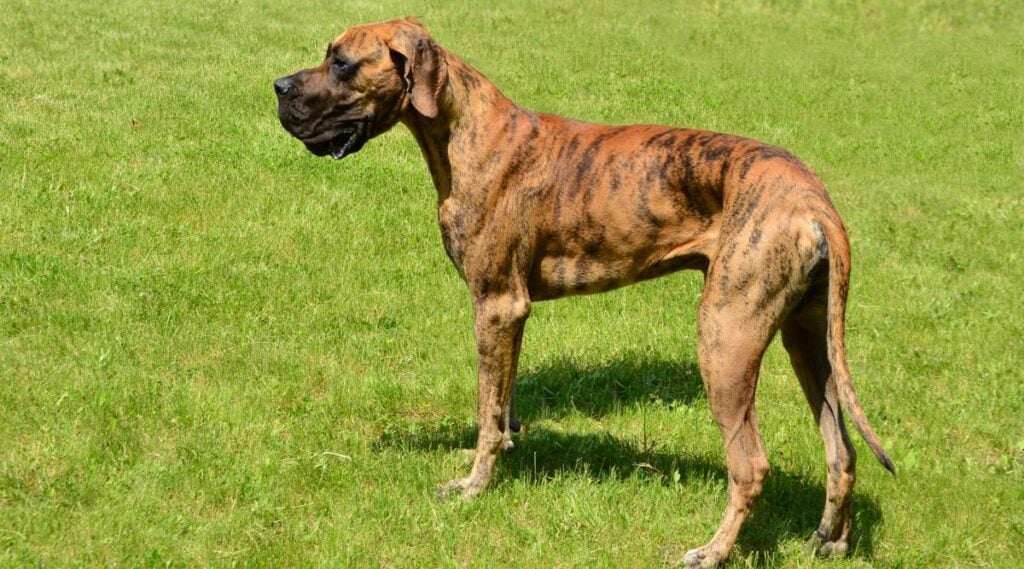
The base color of brindle-colored Great Danes is yellow and gold, always with black cross stripes, sometimes in a chevron pattern. The more intense the base color, the more distinct the stripes are, which is the preferred look. The stripes should be evenly distributed, too.
When it comes to patterns and markings on brindle Great Danes, they often have black facial masks and black-tipped ears and tails. White marks on the chest or toes and dirty-colored brindle coats (not distinct) are undesirable.
Fawn

The preferred fawn color is a bright yellow-gold rather than a subtle light brown. Fawn-colored pups should have black around the eye rims, eyebrows, and a black mask. Black may also appear on the ears and the tail tip. White markings on the chest or the toes, black-fronted, or dirty-colored fawns are undesirable.
Although technically speaking, Scooby-Doo’s color coat doesn’t exist in the Great Dane world. It is more brown, with black spots, than a fawn. Fawn is a recessive gene. Despite this, the color fawn is a common color in the breed.
Blue
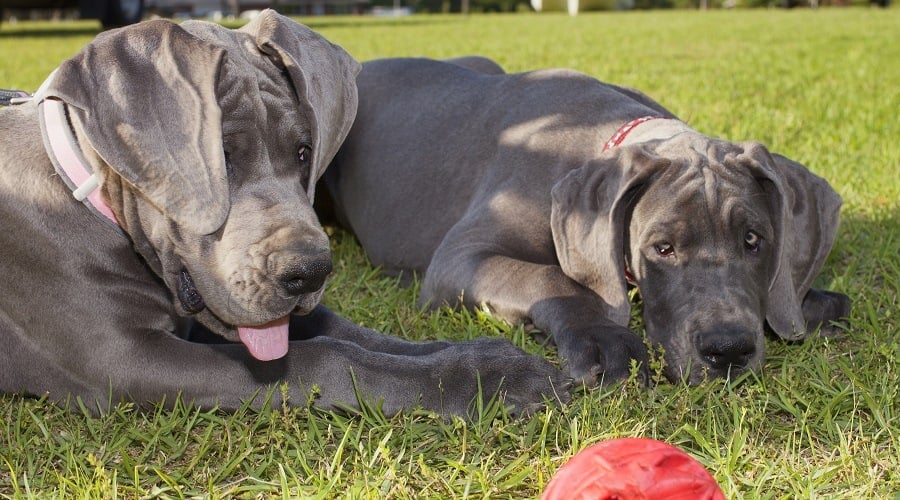
Darker and lighter shades of blue exist, but in the show ring, preference is given to pure steel dogs. White markings on the chest and toes, or any other markings on this coat, are undesirable.
This standard color is surrounded by controversy in the dog world because, technically, it is a diluted version of the black coat rather than blue. It’s also relatively rare because it is a recessive gene. Because of the rarity of this color, it is a sought-after shade.
Black
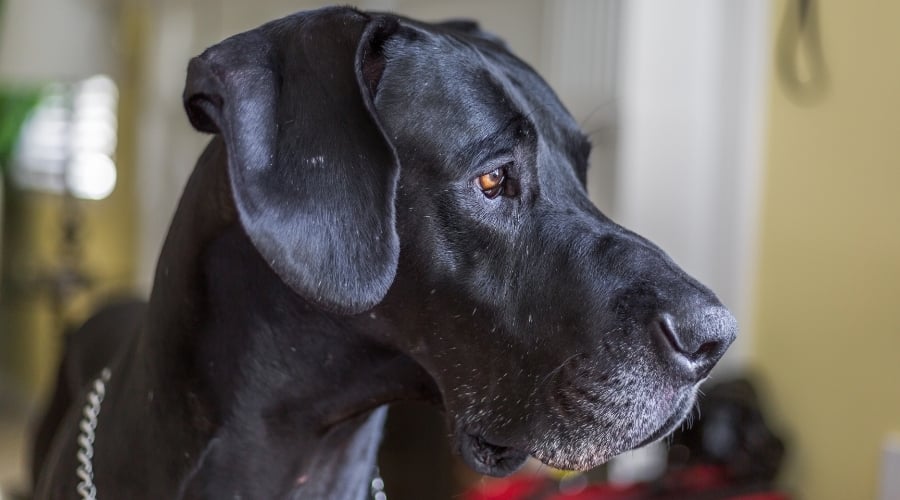
Black-colored Great Danes should be black and glossy, without any white markings on the chest to toes. Black Great Danes are striking. Not only because black dogs are mysterious but because their glossy coat creates a galactical look.
Harlequin
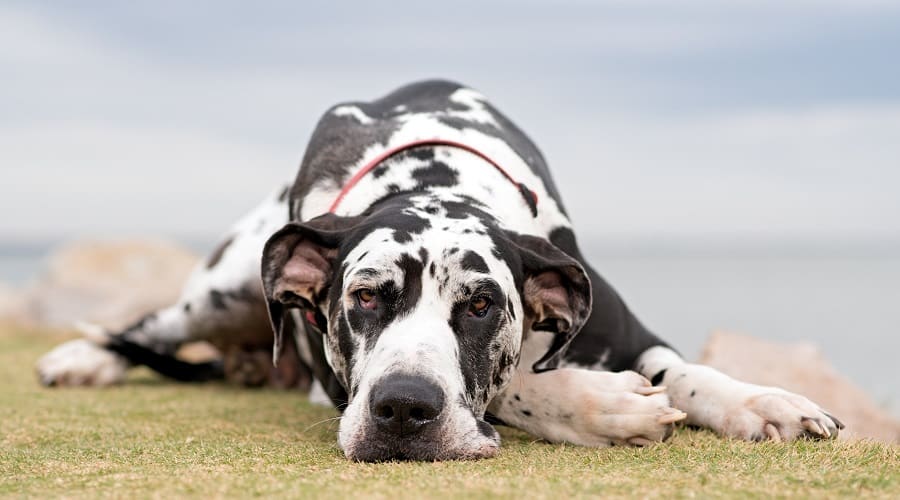
The base color of this coat is white and smothered with well-distributed black torn patches. Merle patches are also typical in this coat color. The neck should be wholly or partially white. None of the patches should be large enough to look more like a blanket of color than a patch. Sometimes you might find black hairs poking through a white base coat. However, this is more salt and pepper than harlequin and, therefore, less desirable in the show ring.
Harlequin is a very sought-after color thanks to its uniqueness compared to one block color. However, it is another rare color. Due to the dominant white gene, some harlequin-colored pups have health issues such as congenital deafness. So, although it is a popular color, you need to be sure that harlequin pups are healthy and have working ears. Responsible breeders should only breed harlequins to mantle rather than two harlequins together, as this can reduce health problems.
Mantle
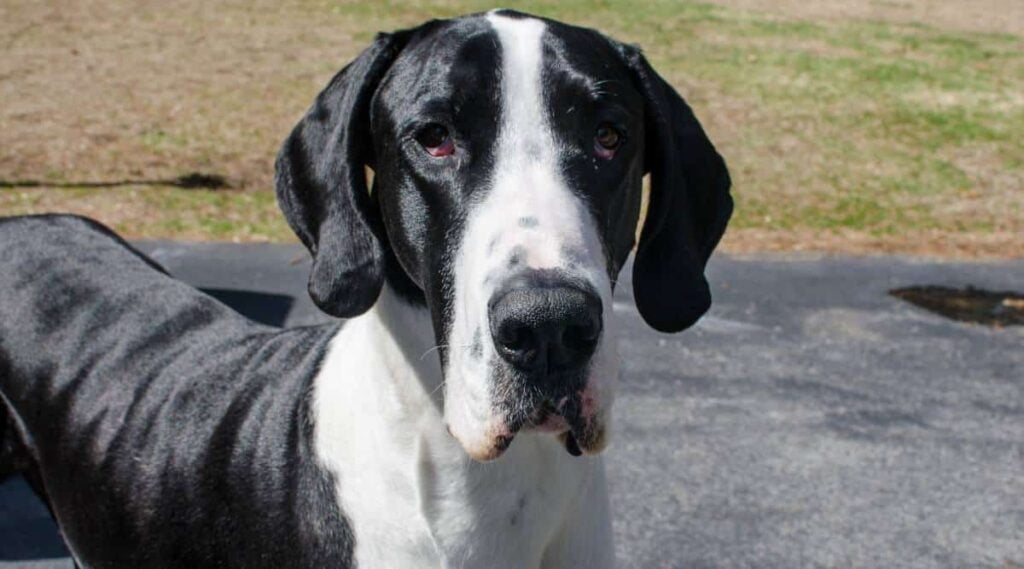
The color mantle is a black and white coat, with a black blanket extending over the body. They usually have a black skull, a white muzzle, and sometimes a white blaze. They are also allowed to have a whole or partial white neck, a white chest, white on the whole or part of the forelegs and hind legs, and a white-tipped black tail.
Mantle-colored Great Danes are often called “Boston Great Danes” because of the similarity between their coat and the Boston Terriers. But breeders try to avoid this label now because of the confusion it causes – a mantle Dane is not a Great Dane mix.
Merle
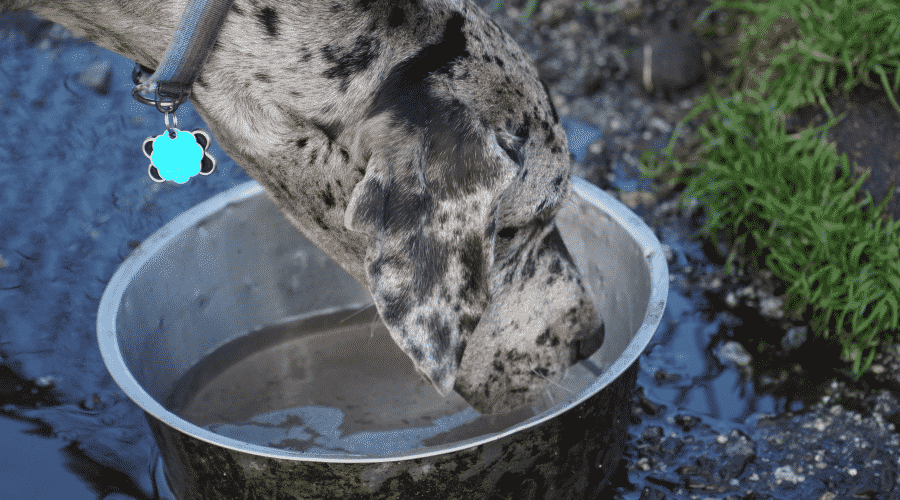
Merle Great Danes have a pale gray to dark gray merle base color, with black torn patches within. The coat can be a solid merle or a merle with a merle mantle pattern described above. White markings are allowed over the body, such as a white muzzle, white neck, white chest, white legs, and a white-tipped merle tail.
Merle is a new Great Dane color, only officially recognized in 2018. Like all merle-coated dogs in other breeds, it is a unique and pretty color that is hugely desirable. Unfortunately, many merle-coated dogs have an increased risk of color-related health issues. This is particularly true in puppies with two merle parents. A double merle pup will likely experience health problems like heart defects, neurological problems, and eye, skin, and ear issues. So it’s important to ascertain they are not a double merle.
Black & White
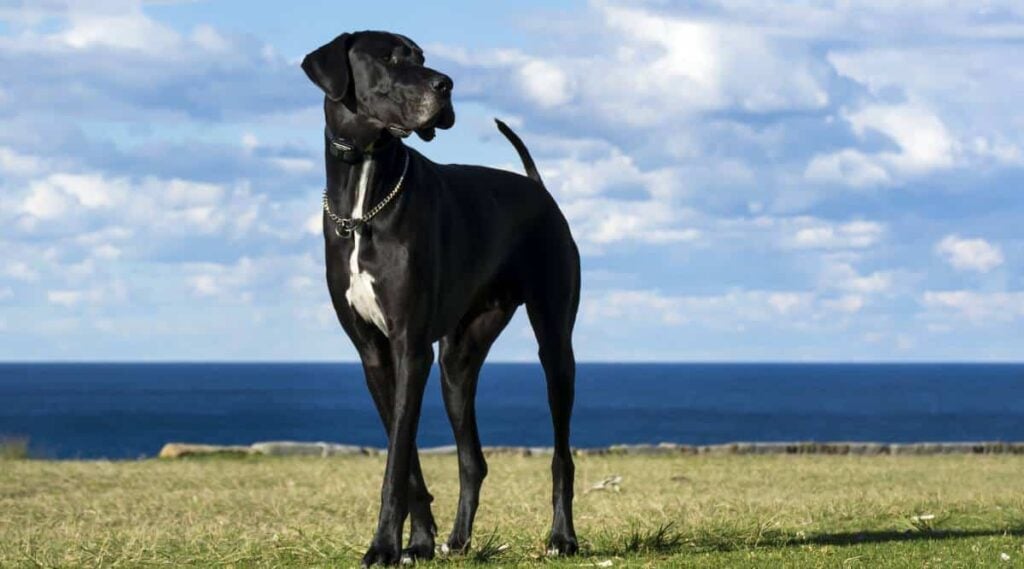
According to the AKC, black and white is standard, but not in the show ring. They are automatically disqualified. The white markings are limited to certain areas of their body, but black is the primary and dominant color. They are often confused with mantle Great Danes.
White
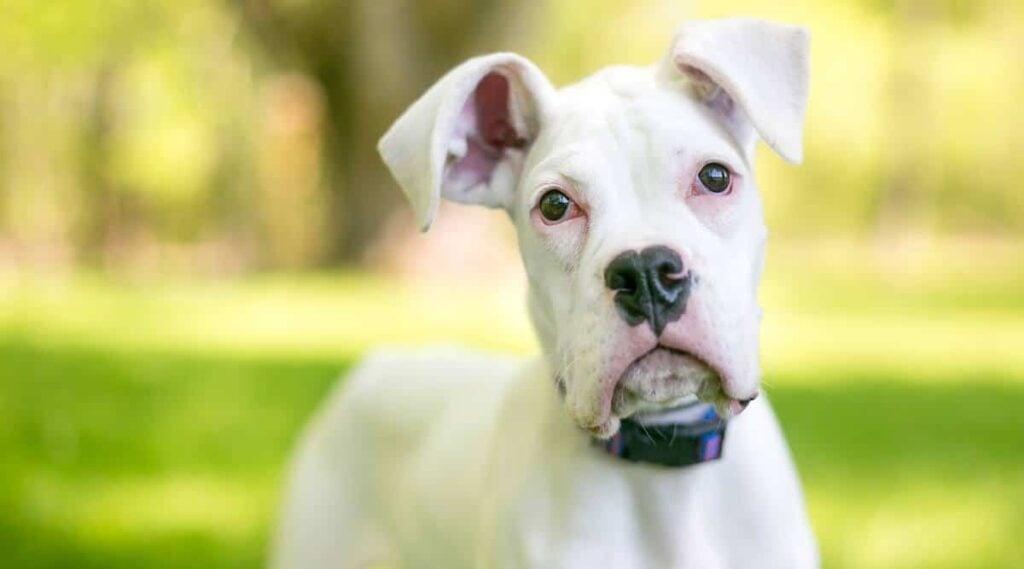
According to the AKC, white is a standard color, but it results in automatic disqualification in the show ring. They are beautiful-looking dogs, much like a white Doberman but on a larger scale.
White Great Dane puppies are common in merle-to-merle litters, putting them at a higher risk of health problems. Not only should you ensure they aren’t a result of a merle-to-merle mix, but you also need to ensure they don’t suffer from albinism. Albinistic dogs also suffer from health problems and usually have a shorter lifespan.
Silver
Silver Great Danes are very similar to blue Danes, and although the color is listed as standard, it is not welcome in the show ring. The silver gene dilutes a black coat, just like the blue gene. Compared to the blue Dane, this diluted black color is pale or dull, unlike the blue coat that is more vibrant and steel blue.
Non-Standard Great Dane Colors
There are many Great Dane color combinations. Here are some of the most common and popular non-standard colors.
Chocolate

Although the AKC does not accept them as show dogs, they make great family pets like all the other colors on this list. Chocolate-colored Danes usually have chocolate noses and skin, too. They are rare, so some breeders might price them higher than their standard-colored siblings.
Fawnequin
A fawnequin-colored pup is essentially a harlequin-colored pup, but instead of black markings, they are fawn-colored. This color isn’t mentioned on the AKC page at all, and it is very rare. Regardless, they are just as cute and special, but don’t expect to be showing them anytime soon.
Mantle Merle
Mantle merle coats have a white color base. Like the mantle Great Danes, they have specific markings similar to the Boston Terrier. But instead of being black, they are merle-colored patches and blankets. Their uniqueness makes mantle merle a popular coat color choice.
Merlequin
Merlequins are one of the most popular non-standard colors, and that’s because of their unique colored coats. Thanks to the white coat base and spots, they look very similar to harlequin coats. Except the majority of the spots are merle color or grey.
Frequently Asked Questions
Which Great Dane Colors/Patterns Are Disqualified From The Show Ring?
This is what the breed standard has to say about color disqualifications:
Disqualification: Merlequin, a white dog with ONLY patches of merle. Faults of Patterns/Markings shall NOT carry as much weight as faults of conformation and breed type. Any variance in Patterns/Markings as described in the above colors, shall be faulted to the extent of the deviation. Any COLOR other than the seven described shall be disqualified.
American Kennel Club
Do Great Danes Change Color?
Some Great Danes change color slightly as they transition to their adult coat. They can become lighter or darker, and many factors influence it. These can include diet, exposure to sunshine, underlying medical conditions, or hair regrowth after an injury. This is why you should wait until your Great Dane has fully grown their adult coat before entering them into a competition.
What Great Dane Color Is The Most Common?
The most common and widely recognized Great Dane color is fawn. Fawn is what the famous character Marmaduke is. However, colors such as harlequin and merle are becoming increasingly popular because of their uniqueness and striking appearance.
What Great Dane Color Is The Healthiest?
Generally speaking, the healthiest Great Dane colors are the standard ones the AKC accepts. Responsible breeders breed for health according to the breed standard and not for color. But there is one exception, and that is merle. Studies show increased health-related issues in merle-coated dogs and even more in double merles. But this does not mean merles are automatically unhealthier than fawn or black-colored Danes. Regardless of their color, your dog comes from a responsible breeder or trusted rescue organization, and be sure to ask for the relevant health certificates.
Being one of the largest dog breeds, your Dane’s medical bills can be sky-high, so proactively signing up for pet insurance while your dog is young ensures better coverage for your vet bills in a time of emergency.
Final Thoughts
Now you know all the standard colors in the Great Dane rainbow and a handful of the non-standard colors. Great Danes come in various colors and patterns, which is part of their beauty. It’s essential to pick a pup based on their personality rather than color. Please be wary of irresponsible breeders who only breed for color. Remember to carry out your research and ask for health certificates.



